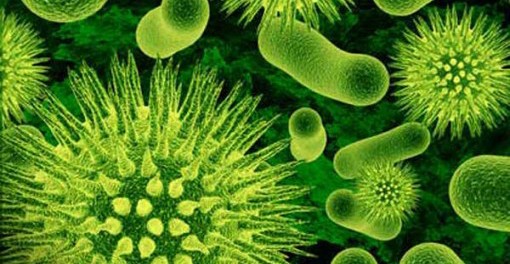GERMS: Small but TERRIBLE
Anything and everything is a potential breeding ground for germs, microorganisms that attack the body and can cause illnesses and infections. They can live in unexpected areas such as kitchen sinks, toothbrushes, condiment containers, on remote controls, computer keyboards, desks, telephones, and even on our own hands. Since practically any place can be a battleground, it would be wise to know your “enemy” and how to prevent a microscopic invasion. It is no wonder there is a growing number of “germaphobes” who are always armed with antibacterial hand wipes and gels ready to fight off these minute enemies.
Different Types of Germs
Bacteria. Single-celled, self-reproducing organisms that can be found in almost every surface of the world. They get nutrients from their environments to nourish themselves. Clearly, the human body would be suitable environment for them.
There are two kinds of bacteria, the good and the bad. The good bacteria helps keep the balance in all things. The bad bacteria, which is also known as the pathogenic bacteria, is responsible for illnesses. Out of the 1,600 species of known bacteria, only less than 200 are disease-causing. Pathogenic bacteria can cause illness in at least three different ways: by invasive action (directly invading and attacking a part of the body); by making toxins, chemical byproducts that act as poisons to the body; or by forming large clumps that can block tiny blood vessels or interfere with the normal closing of the heart valve.
Viruses. They carry the same ability as bacteria to replicate themselves and reproduce rapidly. However, a virus needs a host and can’t survive very long outside living things like human beings and animals. When viruses are inside the human body, they spread and make people sick but unlike most bacteria, almost all viruses can be deadly. They invade the body’s cells until it loses the ability to function normally.
Fungi. Made up of many cells similar to those of plants. It is a group of 50,000 species of simple plants that cannot produce their own food. To survive, it gets nutrition from plants, animals, and the human body. Fungi also like to live in warm places, particularly indoors. This type of germ may not be as dangerous as bacteria or viruses but it can still cause certain diseases in humans.
Protozoa. Single-celled organisms found in the earth’s fresh water deposits, oceans, and soil. 30,000 protozoan species live on this planet but only a few are disease-causing. This particular group of protozoa spreads through contaminated water, infected food and dirty hands.
COMMON DISEASES Caused by Germs
Germs can cause illnesses and worse, death. The following are the common diseases caused by the different kinds of germs:
Cholera, a disease caused by a bacterium called Vibrio Cholerae that infects the human intestine. It is transmitted through contaminated water or food. According to the World Health Organization, this disease is a serious public health problem among developing world populations that have no access to clean and adequate water.
Typhoid fever. A major health problem in developing countries with poor environmental hygiene. The World Health Organization defines typhoid fever as a bacterial disease caused by Salmonella Typhi and people acquire this disease through ingestion of contaminated food or drink. Since viruses cannot exist on their own, they use their hosts to spread diseases, including the common cold, influenza and dengue.
Common Cold viruses cause people to sneeze and can bring on an irritated throat and runny nose. The rhinovirus is to blame for the 10% to 40% of colds, the corona virus accounts for 20% and the respiratory syncytial virus (RSV) responsible for 10%.
Influenza or simply referred to ‘flu’ a disease caused by RNA viruses. From 1979 to 2001, 41,400 people died in the United States from influenza. This disease is spread through the air by cough or sneeze creating aerosols, which contain the virus. In serious cases, this can lead to Pneumonia.
Ringworms are really not caused by worms. This fungal disease is caused by dermatophytes that live on the dead tissues of people’s skin, hair or nails. This kind of illness although mild is a problem in some countries of which personal and domestic hygiene are poor. Good personal hygiene is the best solution for this disease.
Athlete’s foot, a form of ringworm that affects the upper layer of the foot’s skin causing it to become dry, flaky, red and scaly. Tricholhyton causes athlete’s foot and it is a form of fungus found mostly on floors and in clothing. People who have this kind of disease should regularly wash their feet with soap and water, and to keep their feet dry.
Malaria infects more than 219 million people each year leading to approximately 660,000 deaths. This protozoan infection is caused by one of the four protozoa in the Plasmodium genus and transmitted through the anopheles mosquito. 90% of malaria deaths occur in Africa according to United Nations Children’s Fund (UNICEF).
TRANSMISSION of GERMS and DISEASES and HOW TO PREVENT IT
Germs can spread everywhere and can be transmitted through different ways. One of which is through water.
WATER borne diseases are transmitted through the contamination of drinking water, which may come from water systems with urine and feces of infected animals or people. Diseases of this type occur when public and private drinking water systems are contaminated with water from the rain, creeks, rivers or lakes that may have been exposed to dangerous factors.
E coli, diarrhea and cholera are the common types of diseases caused by water contamination. Clean water is the most important resource to reduce the spread of these diseases. Water can be purified to remove toxic elements but if there is no access to a water purification system, it would help to boil the water several minutes before drinking it. Always keep the drinking water containers clean by washing them regularly.
AIR borne Diseases from germs can also be transmitted through the air. Airborne diseases are caused by microbes that are discharged through coughing, sneezing or close personal contact with other people. Prevent the spread of airborne diseases by staying at home when sick, covering the mouth when coughing and sneezing, using a face mask, and practicing good sanitary habits. Pneumonia, chicken pox, and tuberculosis are just some of the diseases that spread easily through the air.
CONTACT diseases. These type of diseases spread via direct contact with an infected person. The microbe is passed from an infected person to an uninfected person. Meningitis and Severe Acute Respiratory Syndrome (SARS) are the common examples of contact diseases. This can be prevented by always washing your hands after contact with any possible infectious material or persons, and by not sharing your personal items with other people.
FOOD borne diseases are acquired through the ingestion of raw or undercooked meat products, unpasteurized milk, raw vegetables contaminated by soil, or by food prepared using contaminated water. An estimated 5.4 million people experience food borne diseases in Australia per year. Bacteria like salmonella, viruses and toxins in food e.g., Staphylococcus aureus are the types of agents that cause illnesses from food. Food borne diseases can be prevented by frequently washing hands with soap and running water for at least 10 seconds and drying them with a clean towel. People with symptoms of food borne diseases must not be allowed to prepare food for other people to prevent the spread of germs. It is best to eat food that have been fully cooked and served hot and to avoidood sold on the streets.
PRACTICAL TIPS to Prevent the Spread of Germs
Prevention is always better than cure. Here are some practical ways on how can we prevent the spread of germs.
At school
- Avoid close contact. Avoid having close contact with people who are sick. If you are sick, try to stay at home for faster recovery and to prevent people from getting infected.
- Cover your mouth and nose. When sneezing or coughing, cover your mouth and nose with a hanky, towel or facial mask. Germs can travel faster in the air and have longer ranges.
- Keep your hands clean. Wash your hands regularly to protect yourself from germs. Hand sanitizers or antibacterial hand wipes are also useful in case a washroom is not available.
At Work
- Disinfect telephones and keyboards. Telephones can hold more than 25,000 germs per square inch while keyboards have more than 200 times as many bacteria as a toilet seat. Use disinfectant wipes to clean small working surfaces.
At Home
- Use disposable cloths or paper towels.
- Wash brushes regularly.
- Mops should be cleaned, disinfected, and dried after every use.
- Use disinfectants when cleaning toilets; also clean the handle and rims of baths and sinks.
- Let the shower run with hot water if not used for a long period of time.
- Ensure kitchen surfaces are wiped clean before food preparation.
- Mop floors with warm water and disinfectant to remove dirt.
- If you have pets, always wash your hands after touching animals.
- Children’s toys should be stored once they have been cleaned and dried.
- Run the washing machine once a week to prevent the growth of germs.
_______________________________
References:
Guardian technologies. (accessed June 13, 2013);
Mania Web (accessed June 14, 2013);
Kids Health (accessed June 14, 2013)
Queensland Government (accessed June 20, 2013)
World Health Organization (accessed June 20, 2013)
Dr. Ananya Mandal, MD. NEWS MEDICAL (accessed June 20, 2013)
NEWS MEDICAL (accessed June 20, 2013)
WebMD (accessed June 21, 2013)
Christian Nordqvist. Medical News Today (accessed June 21, 2013)
Laura Latzko. eHow health (accessed June 21, 2013)
Unicef (accessed June 21, 2013)
MagaLies Water (accessed June 20, 2013)
citeHR (accessed June 20, 2013)
Maine.gov (accessed June 20, 2013)
LabSpace (accessed June 20, 2013)
NSW GOVERNMENT (accessed June 20, 2013)
Centers for Disease Control and Prevention (accessed June 20, 2013)
Jenille Matz, MPH. my Optum Health (accessed June 21, 2013)
Darice Britt. The Ethical Issue.
NHS choices http://www.nhs.uk/Livewell/homehygiene/Pages/prevent-germs-from-spreading.aspx (accessed June 21, 2013)

